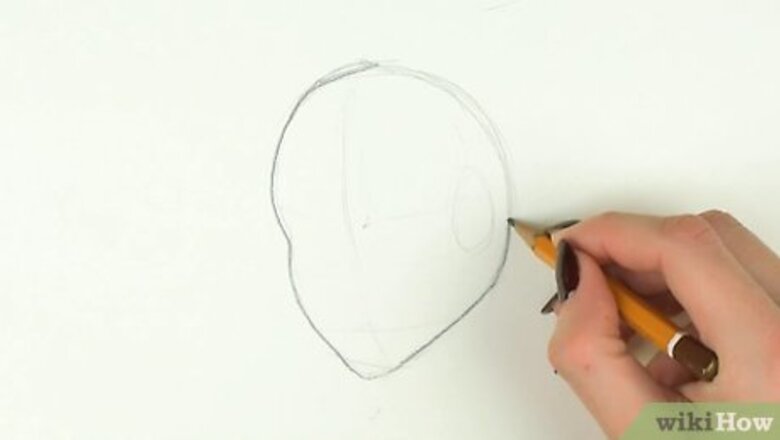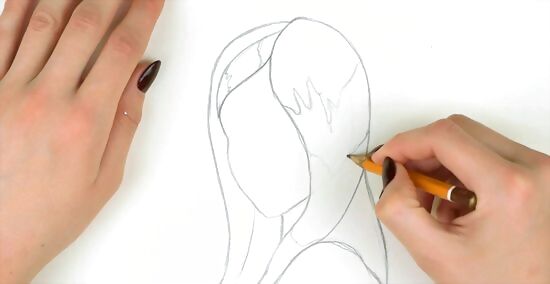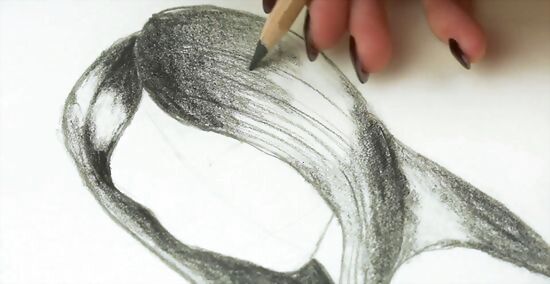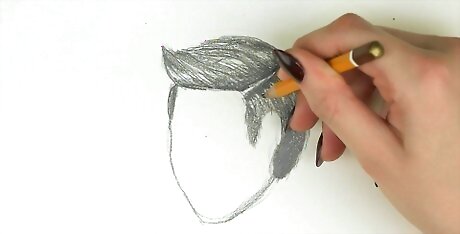
views
Drawing Realistic Long Hair

Draw the outline of the head. It’s hard to draw hair accurately without at least the outline of the head. You need to see how the hair flows in relation to the head as you’re drawing. Use a reference photo and draw the outline of the person’s head, including the top and sides (even if they’re covered by hair). To draw a head without a reference photo, sketch an oval that’s narrower at the bottom. Make sure you leave enough room on the page for the ends of the hair. You can adjust the shape of the chin later after you draw the hair.

Sketch the outline of the hair. Start at the top of the head and draw the top and sides of the hair around it. Leave some space between the hair and the head since hair has volume and isn’t perfectly flat. Then, draw the flow of the hair as it cascades down past the face and around where the neck and shoulders would be. The exact shape of the outline will depend on the style of the hair you’re drawing. For straight long hair, draw a straight line on each side of the hair, running from the top of the hair to the ends. For wavy hair, use wavy lines to draw the sides of the hair—the bigger you make the wavy lines, the looser the hair waves will look. For curly hair, just draw the outlines of the curls around the top, sides, and ends of the hair. Don’t worry about drawing all of the individual curls yet.

Divide the hair into distinct sections. Look for visible pieces of hair that are clumped together or overlapping other sections of hair, and draw these sections within the outline to define them. Hair has different layers—the layers in the back may only be partially visible behind the layers in the front. Textured or layered hair will have more visible sections. Hair that’s flat and straight will have less. If you’re drawing curly hair, the individual sections of hair will be really defined. Outline each of the curls within the hair.

Outline the highlights in the hair. If you’re using a model or reference photo, look to see where the light hits the hair. If you’re not, you’ll need to decide where the light is coming from in your drawing. For example, if it’s on the left side of your figure, the highlights would fall on the left side of the hair, and the right side would have more shadows. Outline the shapes of the visible highlights in the hair. Defining them now will make it easier to give the hair a realistic tone and value later on. For example, maybe the light is shining down on your figure, and the hair on the top of their head is reflecting the light. Look at the basic shape that this reflected light makes on the hair, and draw an outline of it in your drawing. The shape doesn’t need to be perfect. You’ll just use this as a reference later. The exact size and shape of the highlights will vary depending on the position and intensity of the light in your drawing. The more intense the light is, the bigger the highlights will be. Generally, highlights appear in thick, distinct sections, and the shapes flow in the same direction as the hair.Tip: If you’re using a reference photo, you can upload it to a free image editing software and posterize it or increase the contrast. This will make the highlights and shadows in the hair more visible.

Shade in the hair around the highlights. Start by lightly shading in all of the hair. Use the edge of your pencil so the shading is blended and uniform. Don’t draw individual strands of hair yet. Then, go over the darker parts of the hair again, like any shadows at the roots or dark areas where pieces of hair overlap. Shading in the hair will help add dimension and make it look more real. Use different grades of pencils if you have them. For example, you could use an 8B for the darkest shadows, a 6B for medium-range shadows, and a 4B for everything else. You’ll be able to create better contrast using a range of pencils.

Draw individual strands throughout the hair to add texture. Working on one section of the hair at a time, draw individual strands in the direction that the hair flows. Start at the roots and draw the strands to the ends of the hair. Press down harder at darker sections of the hair, and lift up on your pencil as you go over the highlights. Use a kneaded eraser to add more highlights if the hair starts to get too dark. Flatten the eraser and swipe the tip across the page to make thin, white strands in the hair.

Continue adding layers of individual strands. Once you’ve added one layer of strands, go back over the hair and add a second, and a third, and so on. Continuing adding more layers until you achieve the level of realism you’re aiming for.
Sketching Realistic Short Hair

Sketch the outline of the head. You’ll have an easier time drawing the hair if you can use the head as a reference point. Find a reference photo and draw the outline of the person’s head. If you don’t want to use a reference photo, draw an oval that’s narrower at the bottom than it is as the top. Don’t worry about making the outline of the head perfect—you can adjust it later.

Draw the basic shape of the hair on the head. Outline the sides of the hair, the top of the hair, and the hairline. End the sides of the hair about halfway down the face. Leave a small gap between the hair and the head to give the hair some volume. The right way to draw the outline will depend on the hairstyle. If the hair is longer on the top than on the sides, outline the shorter hair on the sides of the head so the tops of the outlines are in line with the parts in the hair. Then, draw the outline of the longer hair on top of the head. If you’re drawing short hair that’s the same length all around, just draw one connected outline since there won’t be any noticeable parts in the hair. If you’re drawing curly short hair, draw the outlines of the curls around the top and sides of the head, but don’t draw the individual curls within the hair yet.

Draw outlines around the highlighted portions of the hair. Look at your reference photo to see where the light falls on the hair. If you’re not using a reference photo, you’ll need to decide where the light is shining in your drawing. Once you’ve identified the highlights in the hair, draw a light outline around them so you remember to leave those areas white later on. For example, there may be a band-shaped highlight that wraps around the top of the hair near the roots. Or, if the light is shining on the front of your figure, there may be a lot of highlights scattered throughout the front of the hair. The exact shape and size of the highlights will depend on how strong the light is and where it’s positioned. The stronger and closer the light, the bigger the highlights will be.

Shade in everything except for the highlights. Use the edge of your pencil to lightly shade in the outline of the hair, leaving the outlined highlights white. Make the shading smooth and blended—you don’t want to draw individual strands of hair yet. Then, go back over the shadows in the hair to make them darker. Hair is usually darker by the roots, and there may be shadows where pieces of the hair overlap. Continue to shade in the hair until you’ve captured all of the different values. Try using different grade pencils, like 8B, 6B, and 4B, to help you capture all of the different values in the hair.

Draw clusters of hair throughout the outline. A lot of shorter hair has thick, distinct pieces throughout it, particularly on the top. If the hair is brushed back, draw these pieces of hair coming up and away from the hairline. If the hair is brushed forward, start at the top of the head and draw the pieces of hair coming down toward the hairline and over the forehead. Some of the pieces will overlap. Some of them might be thicker than others, and some of them might stick out straight or curl to the side. If you're drawing textured, curly, or wavy hair, there will be more clusters of hair throughout the outline.

Sketch individual strands of hair within the pieces. Choose a piece of hair and place your pencil at the root. Then, draw a strand of hair extending from the root to the end of the piece using a smooth, fluid motion. If you pass over a shadow in the hair, press harder on your pencil and make that section of the strand thicker. When you go over a highlighted portion of the hair, lift up on your pencil so that area remains mostly white. Continue drawing strands like this until you’ve filled up the piece you’re working on. Then move on to the next piece. Keep doing this until every piece of hair is filled in. This part of the process will take the longest. Work on one piece of hair at a time so it’s easier to keep track of your progress.

Touch up the highlights and shadows. Once you’ve filled in all of the pieces of hair, use a kneaded eraser to carefully touch up any highlights that lost their brightness while you were drawing. You can also use your pencil to shade in any shadows in the hair so they’re darker, which will also help the highlights pop. To become better at drawing read plenty of books about art. Practice by doing sketching. Find someone who can help you to develop an artist's eye.




















Comments
0 comment